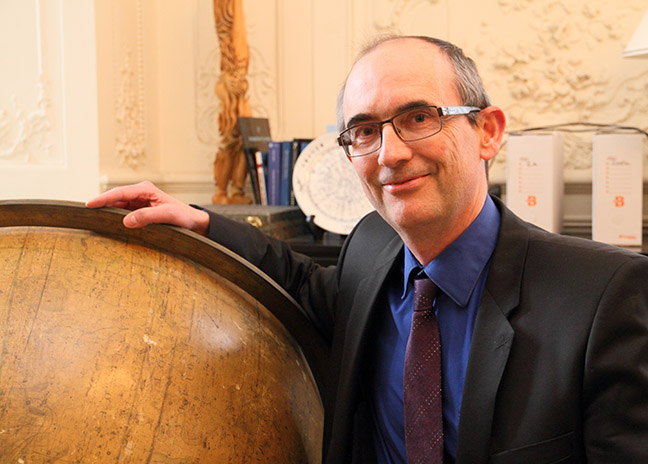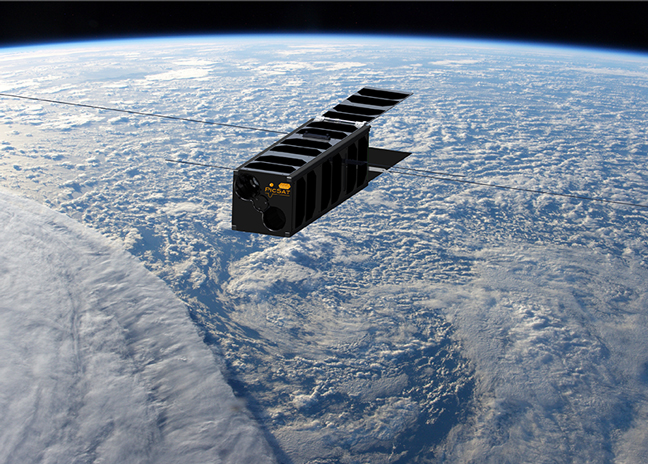Nanosatellites: a new way to go into space
Shaped like three cubes that are just 10 centimeters on each side, weighing no more than a cat (3.5 kg) and consuming the equivalent of an energy-saving light bulb, the PicSat nanosatellite – designed and developed entirely by the Observatoire de Paris - PSL – will be launched into space on January 12th. The innovation will give scientists a better understanding of the Beta Pictoris star system. Observatoire de Paris President Claude Catala tells us more about the major challenges involved in this pioneering project.

PicSat belongs to the family of cubesats, a type of nanosatellite conceived in the United States in 1999 as a way to give universities a low-cost option for sending instruments into space. PicSat weighs 3.5 kg and could fit in a shoe box! It was designed and developed entirely by the Observatoire de Paris-PSL, with support from the ESEP Labex laboratory. On Friday, January 12th, it’s set to be rocketed into orbit by an Indian launcher, PSLV, with PSL covering a significant share of the launch costs, backed by E.U. funding in the form of an ERC Starting Grant.
The project would never have come to fruition without PSL’s support for a new space campus under construction at our site in Meudon, France. The facility is known as C²ERES: Campus and Research Center for Space Exploration. Construction is almost complete and C2ERES is due to be officially inaugurated in the spring of 2018.
C2ERES was conceived from the start as an incubator for educational projects, where Master’s degree students could receive career training in space engineering by designing and producing nanosatellites. But it was also meant to serve as a project development platform for initiatives like PicSat.
An ecosystem for discussing space projects and sharing resources
Whatever the results of the launch set for January 12th, the PicSat project can be deemed a success.
The facility offers comprehensive, customized support for analyzing space missions, drafting development plans, preparing journals and more. Inter-project dialogue is encouraged and made easier by group tools, methodological resources and the ability to share experiences with other project managers.
The Meudon site is home to a collection of equipment for testing nanosatellite components, a concurrent engineering workshop for integrated study of space systems and an area specially set aside for projects by student trainees. In addition, there’s a UHF/VHF ground station for flight operations. Eventually, students will be able to reconstruct missions using the engineering equipment available: with the flight data they gather (orbits, altitudes, system diagnostics, housekeeping), they can reproduce each mission and explain why it performed correctly or incorrectly, then apply those lessons to future experiments.
Together, the project participants form a community of professionals and students and, more broadly, a true academic and industrial network. Students often gain their first experience of a professional network at the facility, while the research professionals learn about exciting developments and encounter a pool of potential partners in the innovative, fast-changing world of cubesats.

A major investment
C²ERES required a range of special equipment (subsystems for cubesats, test benches, a Helmholtz cage, specialized software, etc.) as well as large-scale renovations (redistribution of floor area, asbestos removal, relocation of computer equipment, reinforced flooring, the installation of a vacuum tank, the creation of a clean room, upgrades to the power supply network, etc.). In 2016 PSL contributed €200,000 in funding for those renovations, which were considered strategic insofar as they extend the reach of France’s space program.
Today, that significant investment is bearing fruit to a degree that far exceeds expectations. Produced in just three years despite the extensive development process required for a space project, PicSat is one of the first nanosatellites in the world to be sent into space with a purely scientific objective: to observe the transit of an exoplanet in front of Beta Pictoris and identify its features. Compared to the large satellites that take decades to design and produce, nanosatellites – originally intended for educational and industrial use – are finding greater appeal among scientists. The project represents an emerging new instrumental approach for France’s space research program. Whatever the results of the launch set for January 12th, the PicSat project can be deemed a success.
The PicSat project
PicSat was the brainchild of Sylvestre Lacour, a CNRS researcher at the Observatoire de Paris - PSL, working in collaboration with Alain Lecavelier des Etangs of the Institut d’Astrophysique de Paris (CNRS/Sorbonne Université), who has been studying the Beta Pictoris star system for many years. Sylvestre then made the project a reality at his own laboratory, LESIA (Observatoire de Paris - PSL/CNRS/Sorbonne Université/Université Paris-Diderot), backed by a small team of researchers and engineers. The project represents an emerging new instrumental approach for France’s space research program. The technology was developed at PSL’s C2ERES space campus at the Observatoire de Paris site in Meudon. The PicSat project was primarily made possible by funding from the European Research Council (ERC). It also received financial support from the CNES and the ESEP Laboratory of Excellence as well as the Fondation MERAC, as part of the latter’s campaign to support young researchers in astrophysics.
Crédits photos © Observatoire de Paris-PSL / LESIA
